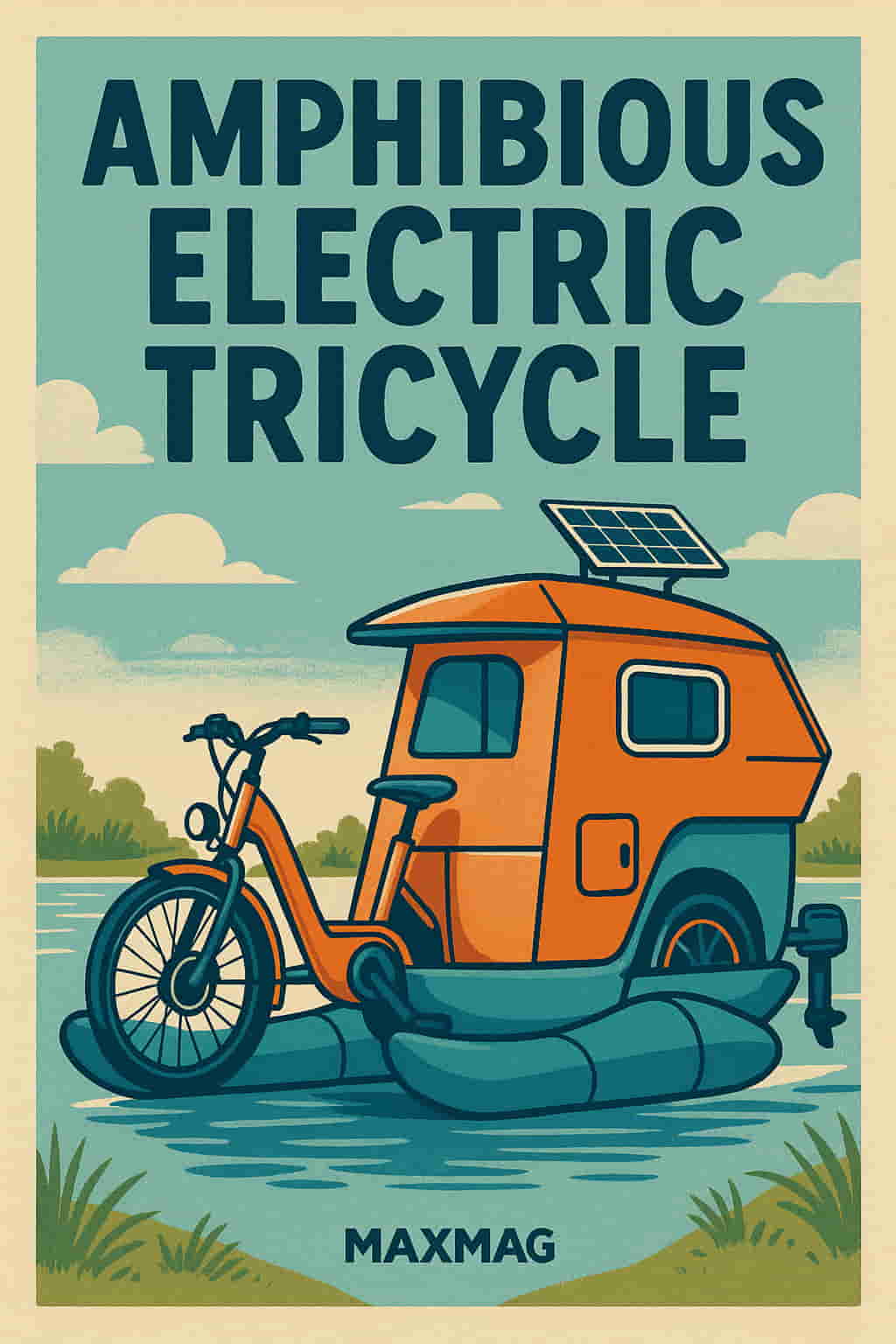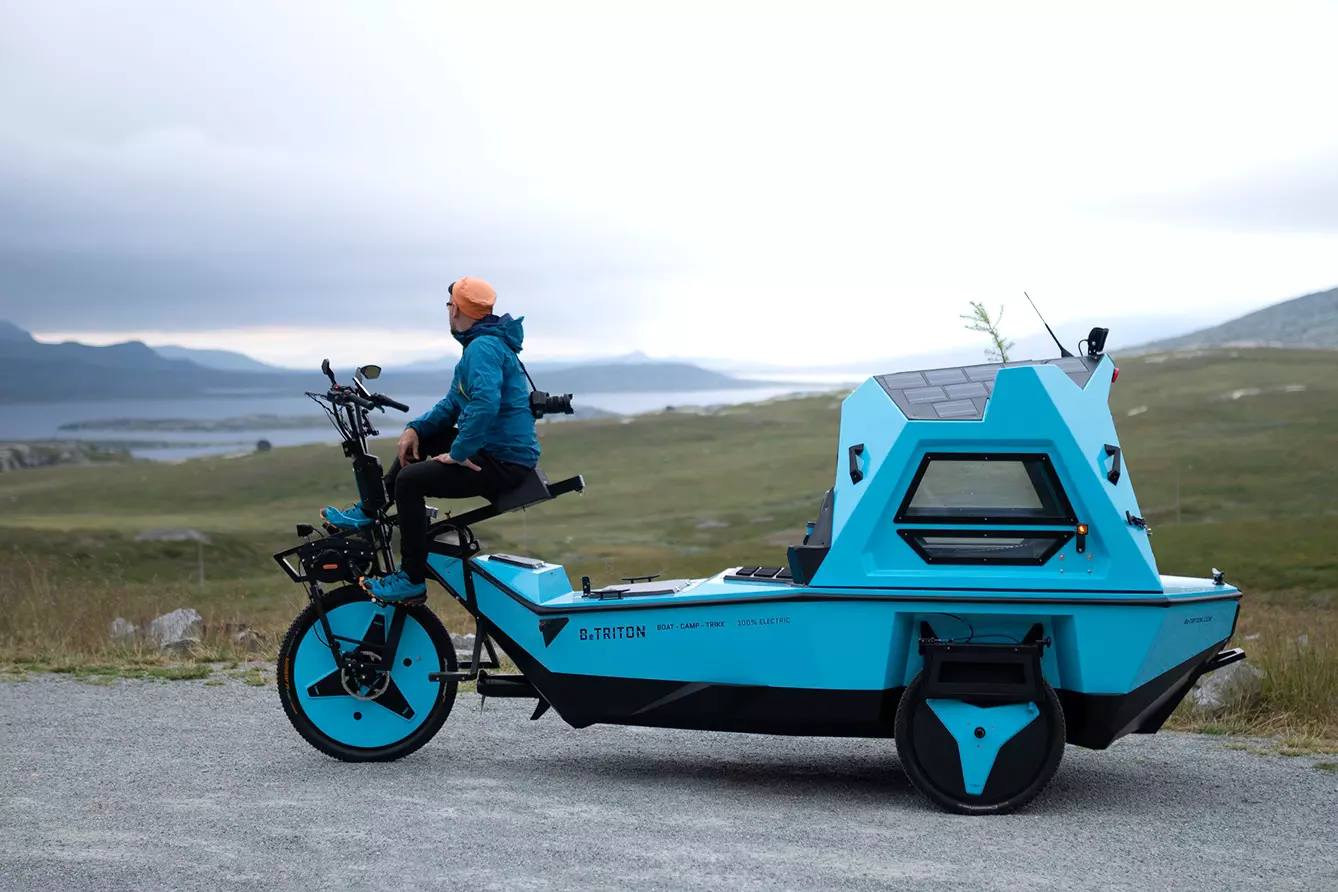
What if your vehicle could pedal like a bike, cruise like a boat, and shelter you like a tent—all in one seamless package? The futuristic dream of a land-water hybrid has arrived with the amphibious electric tricycle, a vehicle that’s changing how we explore, travel, and live. Compact, solar-powered, and cleverly designed, it allows adventurers to journey from road to river and sleep comfortably off-grid.
The amphibious electric tricycle is more than an innovation; it’s a philosophy. It represents a growing desire to live more sustainably, experience nature intimately, and eliminate the limitations of traditional transport. In this article, we’ll explore its features, practical use cases, and why this strange-looking vehicle may just be the next big thing in personal mobility.
What Is an Amphibious Electric Tricycle?
An amphibious electric tricycle is a three-wheeled vehicle designed to move effortlessly across both land and water. It uses a combination of pedal-assist power and an electric motor to support riding on terrain, while a marine electric motor and floatation system allow it to cruise on calm water bodies like lakes and canals.
Its most ambitious version, developed by the European startup BeTRITON (formerly Z-Triton), combines a tricycle, a boat, and a micro-camper—all in a solar-charged setup. You can ride it through the forest, float it across a lake, and spend the night in its built-in cabin.
For those craving minimalist travel and low-impact living, this vehicle is a practical and poetic solution.
Design and Functionality of the Amphibious Electric Tricycle
Let’s break down how this remarkable machine works and what makes it stand out.
1. Pedal-Powered and Electric-Assisted Land Travel
The tricycle operates like a typical e-bike with an electric assist motor (250–500W), allowing riders to travel up to 25 km/h. You can pedal manually or rely on the motor when climbing hills or carrying gear. According to the National Renewable Energy Laboratory, electric transportation systems like this drastically reduce emissions and energy dependence.
2. Seamless Transition to Water
With a clever hydraulic system or manual setup, the vehicle’s pontoons are deployed, allowing the amphibious tricycle to float. A small electric marine motor, powered by the same battery system, enables movement across water at speeds of around 5–8 km/h. In calm lakes or canals, the process takes only 5–15 minutes and requires no tools.
3. Compact Camping Cabin
The built-in shelter transforms into a sleeping space for two adults. Think of it as a cozy micro-RV—offering insulation, ventilation, USB charging ports, and windows. Unlike a traditional tent, it keeps you off the ground and dry, making it ideal for spontaneous overnight stays.
4. Solar-Powered Charging System
One of the most eco-forward aspects of the vehicle is its integrated rooftop solar panel (approximately 200W). During the day, this panel helps recharge the battery, extending the trike’s range. The benefits of solar energy in small-scale transport are widely documented by organizations like Solar United Neighbors, which advocate for sustainable, decentralized energy use.
5. Light, Durable, and Garage-Friendly
Despite its multi-functional capabilities, the entire setup is compact and lightweight. It fits in a standard garage and can be towed by a car if needed. The frame is typically made from aluminum or marine-grade steel, and the pontoons are inflatable or foldable for easy storage.
Who Is the Amphibious Electric Tricycle For?
The versatility of this vehicle appeals to a wide range of people:
-
Digital nomads can live, work, and travel with the freedom of an RV but in a more sustainable and nimble package.
-
Adventure cyclists who want to cross rivers or lakes without detouring can finally do so.
-
Campers and hikers who dislike setting up tents or hauling gear appreciate the all-in-one design.
-
Urban explorers living in waterfront cities (like Amsterdam or Portland) can combine commuting and leisure.
-
Sustainability-minded travelers who prefer off-grid, eco-friendly transportation over cars or motorcycles.
Whether you’re biking along wooded trails, paddling through quiet marshes, or camping beneath the stars, the amphibious electric tricycle is designed to deliver an immersive, zero-emission experience.
Adventures Made Possible by the Amphibious Electric Tricycle
Let’s paint a picture. You start your day on a wooded trail, pedaling past trees and fields. A few hours later, you reach a peaceful lake. Rather than turning back or loading your trike onto a ferry, you simply inflate the pontoons, activate the marine motor, and glide across the water. Once ashore, you ride a bit further, find a quiet spot, and settle in for the night inside your fold-out cabin.
This is not a hypothetical—this is real.
More and more adventure cyclists are looking to avoid cars and achieve “trail-to-shore-to-campsite” travel. Organizations like the Adventure Cycling Association have been expanding awareness around creative cycling and bikepacking routes across the U.S., but most are limited by terrain or water access. An amphibious trike removes that limit.
Even glamping businesses and eco-tourism companies are beginning to see potential in these hybrids for offering unique rental experiences without requiring infrastructure like roads or docks.
Performance and Specifications
While specs vary depending on the model, the average amphibious electric tricycle includes:
| Feature | Specification |
|---|---|
| Top Speed (land) | 25 km/h (pedal + electric assist) |
| Top Speed (water) | 5–8 km/h (electric marine motor) |
| Land Range | 80–100 km (with battery + pedaling) |
| Water Range | 20–30 km (depends on battery size) |
| Solar Panel | 200W rooftop solar for passive charging |
| Sleeping Capacity | 2 adults |
| Setup Time (land/water) | ~10 minutes |
| Cargo Capacity | ~100 kg (gear, food, pets, etc.) |
With these specs, travelers can plan multi-day excursions without needing gas stations, hotel reservations, or public transportation. According to Treehugger’s clean mobility section, hybrid travel solutions like this may become essential as cities reduce car traffic and promote green spaces.
Maintenance, Legal Use, and Practical Tips
Maintenance:
Maintenance is similar to that of an e-bike, with additional marine components. Routine checks include tire inflation, chain lubrication, waterproofing seals, battery health, and solar panel alignment.
Legal Use:
In many countries, it’s classified as an electric bicycle (land) and a non-motorized vessel (water), meaning you don’t need a license in most places. However, always check local laws for watercraft registration.
Insurance:
Some specialized insurers now offer micro-RV or cargo bike insurance policies. If you’re using the vehicle for business (e.g., rentals), liability coverage is recommended.
Cost and Availability:
DIY kits may start at around $5,000. Fully equipped models, such as the BeTRITON, range from $15,000 to $18,000. While this may seem steep, it replaces a boat, a camper, and a bike—and requires no fuel. Rentals are emerging in eco-tourism hotspots across Europe and may soon reach North America.
FAQ: Amphibious Electric Tricycle
Q1: Can it handle ocean travel?
No, these vehicles are designed for calm freshwater—lakes, canals, and slow rivers. Saltwater is corrosive and unsafe for the structure.
Q2: How long does the battery last?
Battery range varies based on terrain and motor usage. On land, expect up to 100 km; on water, 20–30 km. Solar panels extend range over time.
Q3: Can I live in it full time?
It’s possible for minimalists, but most use it for weekend or extended adventure trips. Think of it as a portable eco-cabin.
Q4: What’s the learning curve?
If you know how to ride a bike and steer a small boat, you’re set. Setup is simple and requires no mechanical expertise.
Q5: Where can I try or rent one?
BeTRITON offers rentals in parts of Europe. As interest grows, expect U.S.-based eco-parks and glamping sites to follow suit.
Conclusion: Freedom Reimagined
The amphibious electric tricycle is not a gimmick—it’s a transformative tool. It blends mobility, sustainability, and simplicity in a way that few vehicles can. Whether you’re exploring city canals, remote hiking trails, or lakeside hideouts, it offers a freedom few other vehicles can match.
In a time when travelers are seeking slower, more conscious experiences, this trike delivers. It’s not about speed—it’s about the journey. And now, with land and water at your wheels, that journey just got a lot more exciting.





